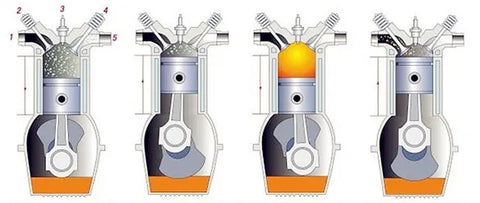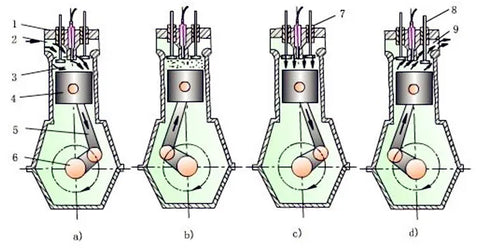Abstract:The four-stroke gasoline engine works on the same principle as the four-stroke diesel engine. Each working cycle consists of four strokes: intake, compression, power, and exhaust. Structurally, a gasoline engine has multiple carburetors, high-voltage lines, distributors, and spark plugs; while a diesel engine has multiple high-pressure pumps; in terms of operation, a gasoline engine has the functions of suction, compression, ignition, and explosion operation, and exhaust; while a diesel engine has suction, compression, and high-pressure operation. Pump oil, exhaust steam.
1.Working principle of four-stroke gasoline engineA four-stroke gasoline engine completes a working cycle through four strokes: intake, compression, combustion, and exhaust. During this period, the piston moved four strokes back and forth between the top and bottom dead centers, and the crankshaft rotated two weeks accordingly.

- Intake stroke
During this stroke, the piston moves from the top dead center to the bottom dead center, the intake valve opens, the exhaust valve closes, and the crankshaft rotates 180 degrees. When the piston moves from the top dead center to the bottom dead center, the pressure inside the cylinder drops and the mixture of gasoline and air is sucked into the cylinder through the intake valve. Due to the intake resistance, when the piston reaches the bottom dead center, the gas in the cylinder The pressure is below atmospheric pressure.
- Compression stroke
During the compression stroke, the piston moves from the bottom dead center to the top dead center, the intake and exhaust valves are closed, and the crankshaft rotates 180 degrees. When the piston moves from the bottom dead center to the top dead center, the temperature and pressure of the mixture in the cylinder continue to rise, making it easy to ignite. A larger compression ratio is beneficial to improving the power and economy of the engine, but if the compression ratio is too high, it can easily cause the engine to work abnormally.
- Work stroke
During the power stroke, the intake valve and exhaust valve are closed, the piston moves from the top dead center to the bottom dead center, and the crankshaft rotates 180 degrees. Before the piston reaches the top dead center in the compression stroke, the spark plug ignites the mixture. Under the high pressure generated by the combustion of the mixture, the piston is pushed from the top dead center to the bottom dead center to generate power. The highest instantaneous pressure in the cylinder can reach 3 to 5MPao
- Exhaust stroke
During the exhaust stroke, the piston moves from the bottom dead center to the top dead center, the intake valve closes, the exhaust valve opens, and the crankshaft rotates 180 degrees. When the piston moves from the bottom dead center to the top dead center, the burned exhaust gases are discharged. When the piston reaches the exhaust top dead center, due to the presence of the combustion chamber volume, there is still a small amount of exhaust gas in the cylinder, and its pressure is also higher than the atmospheric pressure due to exhaust resistance. At this time, the piston returns to the initial state of the intake stroke. In this way, the engine cylinder completes a working cycle.
2.Working principle of four-stroke diesel engine
The working principle of a four-stroke diesel engine is similar to that of a gasoline engine. Each working cycle consists of four strokes: suction, compression, power, and exhaust. The difference is that due to the low ignition point of diesel (220°C), there is no need for an ignition device. The fuel mixture in the cylinder can be ignited by compression ignition. Therefore, the compression ratio of diesel engines is generally higher, between 16 and 22.

- Intake stroke
Unlike a gasoline engine, what enters the cylinder is not a mixture, but pure air.
- Compression stroke
What is different from the gasoline engine is that it compresses pure air, and because the diesel engine has a large compression ratio, the compressed temperature and pressure are higher than that of the gasoline engine.
- Work stroke
This stroke is very different from that of a gasoline engine. At the end of the compression stroke, the fuel injection pump sprays high-pressure diesel into the high-temperature air in the cylinder through the injector, where it quickly vaporizes and forms a combustible mixture with the air. Because the temperature of the cylinder at this time is much higher than the auto-ignition temperature of diesel (about 500K), the diesel ignites and burns on its own, and will burn while spraying for a while. The temperature and pressure in the cylinder increase sharply, pushing the piston downward to perform work.
- Exhaust stroke
It is the same as the exhaust stroke of a gasoline engine.
3.Relationships and differences between four-stroke gasoline engines and four-stroke diesel engines
1.What four-stroke gasoline engines and four-stroke diesel engineshave in common
(1) The crankshaft rotates two times (720°) in each working cycle, and the crankshaft rotates a half-axis (180°) in each stroke. The intake stroke is when the intake valve opens, the exhaust stroke is when the exhaust valve opens, and the remaining two strokes Both the intake and exhaust valves are closed.
(2) Among the four strokes, only the power stroke generates power, and the other three strokes are auxiliary in preparation for the power stroke. Although the power stroke is the main stroke, the other three strokes are also indispensable.
(3) In the first cycle of engine operation, there must be an external force to use the crankshaft to rotate to complete the intake and compression strokes. After ignition, the power stroke is completed. The energy stored in the crankshaft and flywheel can be used to complete subsequent strokes and subsequent work cycles. , the engine can do it by itself without external force.
2.The difference between four-stroke gasoline engine and four-stroke diesel engine
(1) The gasoline and air in the gasoline engine are mixed outside the cylinder, and the combustible mixture enters the cylinder during the intake stroke. While pure air enters the cylinder during the intake stroke of a diesel engine, diesel is injected into the cylinder at the beginning of the power stroke and mixed with air in the cylinder, that is, the mixing method is different.
(2) Gasoline engines use electric sparks to ignite the mixture, while diesel engines use high pressure to inject diesel into the cylinder, and rely on high-temperature gas heating to ignite and burn on their own, that is, the ignition methods are different. Therefore, gasoline engines have an ignition system, while diesel engines do not have an ignition system.
If you still have questions about the difference between the two, you can contact us and we can provide you with professional answers and quality-assured products.
















